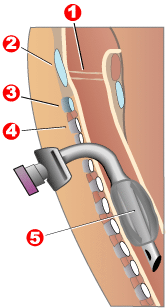
Photo from wikipedia
INTRODUCTION The objective of this study was to evaluate the effect of obesity on outcomes following operative treatment of fractures in obese polytrauma patients. METHODS This was a prospective cohort… Click to show full abstract
INTRODUCTION The objective of this study was to evaluate the effect of obesity on outcomes following operative treatment of fractures in obese polytrauma patients. METHODS This was a prospective cohort study at a level I trauma centre from January 2014 until December 2017. The eligibility criteria were adult (age >= 18 years) polytrauma patients who presented with at least one orthopaedic fracture that required operative fixation. Polytrauma was defined as having an Injury Severity Score (ISS) >= 16. Out of 891 patients, a total of 337 were included with 85 being obese. The primary outcome variable was the total hospital length of stay in days. The secondary outcome variables were the number of patients who had an intensive care unit (ICU) admission, the ICU length of stay in days, the number of patients who had mechanical ventilation, the duration of mechanical ventilation in days, perioperative complications, and mortality. RESULTS Obesity was associated with increased total hospital stay (36 vs. 27 days; P<0.001), increased ICU stay (13 vs. 8 days; P = 0.04), increased ICU admissions (83.5% vs. 68.6%; P = 0.008) and increased incidence of mechanical ventilation (64.7% vs. 43.7%; P = 0.001). These findings remained statistically significant following adjusted regression models for age, gender, ISS, and injuries sustained. However, the mechanical ventilation duration was not significantly different between both groups on adjusted and unadjusted analyses. However, an increase per unit BMI significantly increases the duration of mechanical ventilation (P = 0.02). In terms of complications, obesity was only associated with an increase in acute renal failure (ARF) on unadjusted analyses (P = 0.004). Whereas, adjusted logistic regression demonstrated that an increase per BMI unit led to a significant increase in the odds ratio for wound infection (P = 0.03) and ARF (P = 0.024). CONCLUSIONS This study displayed that obesity was detrimental to polytrauma patients with operatively treated fractures leading to prolonged hospital and ICU length of stay. This highlights the importance of optimizing trauma care for obese polytraumatized patients to reduce morbidity. With 41.1% of our population being obese, obesity presents a unique challenge in the care of polytrauma patients which mandates further research in improving health care for this population group.
Journal Title: Injury
Year Published: 2022
Link to full text (if available)
Share on Social Media: Sign Up to like & get
recommendations!